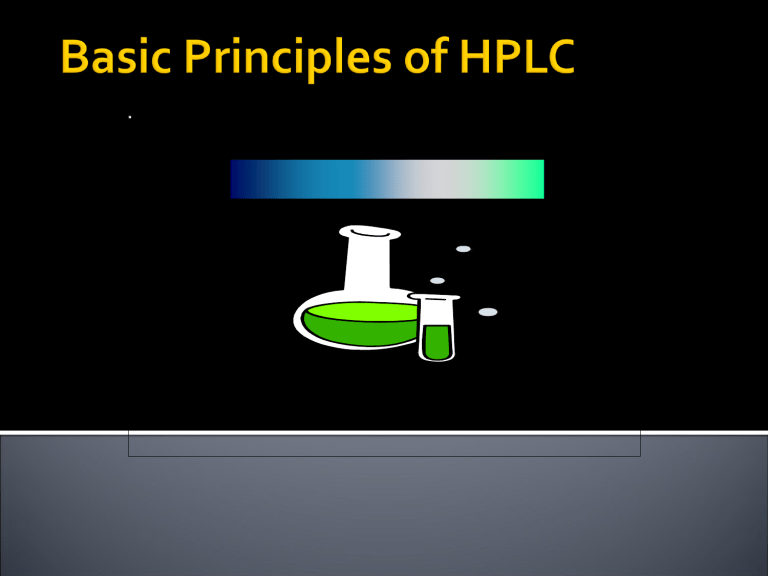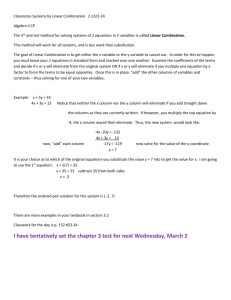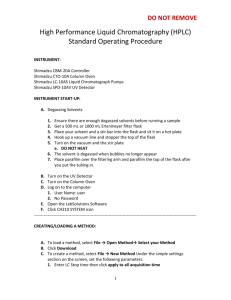Basic Principles of HPLC

igh
P
erformance
L
iquid
C
hromatography
HPLC is a form of liquid chromatography used to separate compounds that are dissolved in solution. HPLC instruments consist of a reservoir of mobile phase, a pump, an injector, a separation column, and a detector.
Compounds are separated by injecting a sample mixture onto the column. The different component in the mixture pass through the column at differentiates due to differences in their partition behavior between the mobile phase and the stationary phase. The mobile phase must be degassed to eliminate the formation of air bubbles.
This unit is equipped with two pump units and a UV/Vis detector.
The gradient is controlled via the pump controllers.
LC methods are not as sensitive to temperature.
Columns are commonly mounted outside the instrument.
Solvents
• All solvents should be ‘HPLC’ grade.
– This is a type of reagent grade material.
– It has been filtered using a 0.2 μm filter.
• Filtered solvent helps extend pump life by preventing scoring. It also reduces the chances of a column plugging.
Solvent degassing
All solvents should be degassed prior to use.
This reduces the chances of bubbles being formed in the column or detector. Oxygen present at high pressure can also cause a problem.
Methods that can be used
! Displacement with a less soluble gas
! Applying a vacuum
! Heating the solvent.
HPLC Injectors
In order to introduce a sample onto the column for analysis, a special valve called the injector must be used to transfer the sample into the pressurized system
Injectors may look different from the outside, but internally, most are 6-port rotary valves. These valves consist of a fixed body (the
"stator") plus an internal seal that rotates (the "rotor").
Three internal passages connect alternate pairs of external ports.
The valves can switch between two positions, referred to as the
"inject" and "load" positions, respectively. In the load position, the pump is connected to the column, and the sample inlet is connected to one end of a piece of tubing, called the sample loop.
The other end of the sample loop is connected to the waste port.
Rotation results in reconnecting the various lines that enter the valve, so that a sample volume can be inserted into the mobile phase that flows from the pump to the column inlet.
The column
HPLC has seen significant improvement over the last 20 years primarily due to improved column technology.
Packings are more uniform and smaller.
Phases are commonly chemically bound to the packing.
Packing methods have improved.
Pump types :
•Isocratic pump
- delivers constant mobile phase composition;
•solvent must be pre-mixed;
•lowest cost pump
•
Gradient pump delivers variable mobile phase composition;
•can be used to mix and deliver an isocratic mobile phase or a gradient mobile phase
Reciprocation pumps
--- advantages: small internal volume, high output pressures, ready adaptability to gradient elution and constant flow rates
--- disadvantages: produce a pulsed flow, cause baseline noise.
Displacement pumps
--- advantages: output is pulse free
--- disadvantages: limited solvent capacity (<250 mL) inconvenience when change solvents
Pneumatic pumps:
--- advantages: inexpensive, output is pulse free
--- disadvantages: limited solvent capacity, not amenable to gradient elution and limit pressures <2000 psi
Packings
Originally, these were irregular silica and alumina. A range of synthetic, regularly shaped packings are now available.
! Porous - channels through packing
!!
Superficially porous - rough surface
!!
Smooth - bead like.
Packing size
As packing size is decreased, efficiency and pressure requirements are increased.
! Common diameters for analytical work diameter ! plates
"" 10 μm "" 5000
"" 5 μm "" 9000
"" 3 μm" " 15,000
All are for a 15 cm x 4.6 mm column
Column body
Typically consist of stainless steel with a high precision internal bore.
Some manufacturers offer column inserts
- " don’t need to repurchase the column
" fittings.
Others offer columns where the external body can be compressed to improve packing efficiency.
HPLC column examples
Column stationary phases
Today, most packing fall into four classes.
Silica or alumina
Bound phases on either alumina or silica.
Gels
Controlled-pore glass or silica
Absorption phases - alumina
! common mobile phases
! hexane, chloroform, 2-propanol.
! example application - amines.
silica
! common mobile phases
! hexane, chloroform, 2-propanol.
! example applications - ethers, esters,
! porphyrins, fat-soluble vitamins.
Partition phases
Can be broken down into
! Normal phase - polar materials bound to the support.
! Reverse phase - non-polar materials bound to the support.
! Mixed phase - ! may have some of each.
Partition phases
Normal
! Amino (-NH2)
! Cyano (-CN)
! Diol (glycidoxy-ethylmethoxysilane)
Reverse
! C-2 or RP-2 (-Si-CH2CH3)
! C-8 or RP-8 (-Si-(CH2)7CH3)
! C-18 or RP-18 (-Si-(CH2)17CH3)
Increasing the C number results in a thicker, more retentive phase
Ion exchange phases
Strong cation ! - sulfonic acid group
Strong anionic !quarternary amine
Weak anion ! - primary amine
Weak cation ! - COOH
Size exclusion phases
Gels - organic or aqueous based
Controlled-pore - silica or glass
Must be selected based on pressure requirements and size range required for your application.
Capillary and Microbore columns.
Several companies have begun offering columns with smaller ID.
Microbore column - 1 mm ID, packed column.
Capillary column - < 1 mm ID, internal bound phase.
These columns require smaller solvent flows, reduced sample size and improved detector design.
Capillary and Microbore columns. Capillary and Microbore columns.
Aromatic Compounds mobile phase!2% ethylacetate in hexane flow rate " 4 μl/min column ""Fusica II, 300μm I.D. x
! ! ! 25 cm silica sample
! 1. toluene
! 2. nitrobenzene
! 3. acetophenone
! 4. 2,6-dinitrobenzene injection! ! 60 nl detection! ! UV 254 nm
Silica based columns
Silica is the ideal support for HPLC columns. It offers a large mechanical stability, excellent physicochemical surface properties, a wide range of bonding chemistries and is compatible with a broad range of organic solvents.
pH stability
In general, HPLC columns are stable within a pH range of
2 to 8. If you are measuring a pH value, the measurement must be done in the aqueous media before mixing the eluent with organic solvents.
Modern HPLC columns can be used outside that pH range. The new bonding chemistries allow use down to pH
1 for some stationary phases. However, please check vendor’s product information before using silica based column outside the pH range of 2 to 8. However, best lifetimes are obtained between pH 2.0 and pH 6.8.
Mechanical stability
Stationary phases based on silica are mechanically very stable. The packed columns show no pressure limit and can be used at more than 40 MPa (6000 psi) without any problem.
However, please avoid pressure shocks on the column. Pressure shocks lead to channelling in the column, which results in peak splitting in the corresponding chromatogram.
Mobile phases (Eluents)
Silica based stationary phases are compatible with all organic solvents in the above mentioned pH range. .
• Filter all prepared buffer through a 0.5 μm filter before using them in your HPLC system
The use of non pure solvents in HPLC causes irreversible adsorption of impurities on the column head. These impurities block adsorption sites, change the selectivity of the column and lead to peak splitting in the chromatogram. In gradient elution, impurities cause so called “
Ghost Peaks
”.
Ghost peaks are peaks that always appear in the same position on the chromatogram. Their origin is not the sample, but the impurities from the solvents or solvent additives. Therefore, it is highly recommended to run a gradientwithout injection in the beginning of each method to determine the ghost peaks
To avoid irreversible adsorption at the column head, you should always use a pre-column.
The use of a pre-column increases the life time of a column dramatically. In addition, a pre-column can filter solid parts stemming from pump seals or injection rotors. An alternative to a pre-column is an in-line filter. These filters are attached directly to the column. These filters get rid of solid parts in the eluent but will not avoid irreversible adsorption of organic impurities
Detector Systems
Virtually every chemical and physical property that can be measured in solution has been look at.
Detectors fall roughly into two classes
Bulk property - measures an overall change in the mobile phase.
Solute property - measures a solute specific property.
Properties of a good detector
A detector must provide
• high sensitivity, low detection limits,
• linearity,
•
Reproducibility.
This is true for any detector.
Each detector will have specific advantages and will vary as to peak shape and spread, noise and flow/temperature dependence they have.
UV/Vis detector
A solute property detector.
Sample must exhibit absorption in UV/Vis range.
Solvent must not absorb significantly at the measured wavelength.
Types " Filter photometer - single
•
Variable wavelength
•
Multiwavelength.
Refractive index detector
Bulk property detector - general purpose.
Based on refraction of light as it passes from one media to another. Presence of a solute changes the refractive index of the solvent.
Heat of absorption detector
A small amount of heat is released when a sample absorbs on a suitable surface.
This detector can measure this.
Electrochemical detectors
A number of properties have been evaluated
Detector types
! ! Dielectic constant
! ! Amperometric
! ! Conductometric
! ! Polarographic
! ! Potentiometric
Dielectric constant detector
Bulk property detector.
Measures changes in polarity of the liquid phase passing through the cell.
Conductometric detector
Measures conductivity of the solvent. Useful for solutions of ions.
Amperometric detectors
Most frequently applied type of electrochemical detector.
A known potential is applied across a set of electrodes - typically a glassy carbon type.
Ability to oxidize or reduce a species can be measured.
Typically limited to working with a specific class of materials per analysis
Separation is based on the analyte’s relative solubility between two liquid phases
Mobile Phase Stationary Phase
Solvent Bonded Phase
Normal Phase.
- Polar stationary phase and non-polar solvent.
• Reverse Phase.
- Non-polar stationary phase and a polar solvent.
Methan0l
• Acetonitrile
• Tetrahydrofuran
• Water
CH
3
OH
CH
3
CN
H
2
O
Solid Support - Backbone for bonded phases.
Usually 10µ, 5µ or 3µ silica or polymeric particles.
Bonded Phases - Functional groups firmly linked
(chemically bound) to the solid support.
Extremely stable
Reproducible
Guard - Protects the analytical column:
Particles
Interferences
• Analytical - Performs the separation.
Prolongs the life of the analytical column
C-2 Ethyl Silyl
• C-8 Octyl Silyl
• C-18 Octadecyl Silyl
• CN
-Si-CH
2
-Si-(CH
-CH
-Si-(CH
2
Cyanopropyl Silyl -Si-(CH
2
)
2
)
7
)
3
3
-CH
17
-CH
-CN
3
3
Gradient
Controller
Mobile Phases
Pump
•
Injector
Column
Detector
UV
Single wavelength (filter) [610, 8330]
Variable wavelength (monochromator) [8316, 8325]
Multiple wavelengths (PDA) [555]
Fluorescence [610]
Electrochemical [605]
Mass Spectrometric [8325]
Restek
®
ULTRA C-18 and CN Columns (250mm x 4.6mm, 5µ),
Mobile Phase: (1:1 Methanol:Water), 1.5 mL/min.
A
Supelcosil LC-PAH Columns.
Conditions: A: 150mm x 4.6mm, 5µ.
B
Conditions: B: 50mm x 4.6mm, 3µ.
Flow Rate: 1.5 mL/min Flow Rate: 3.0 mL/min




